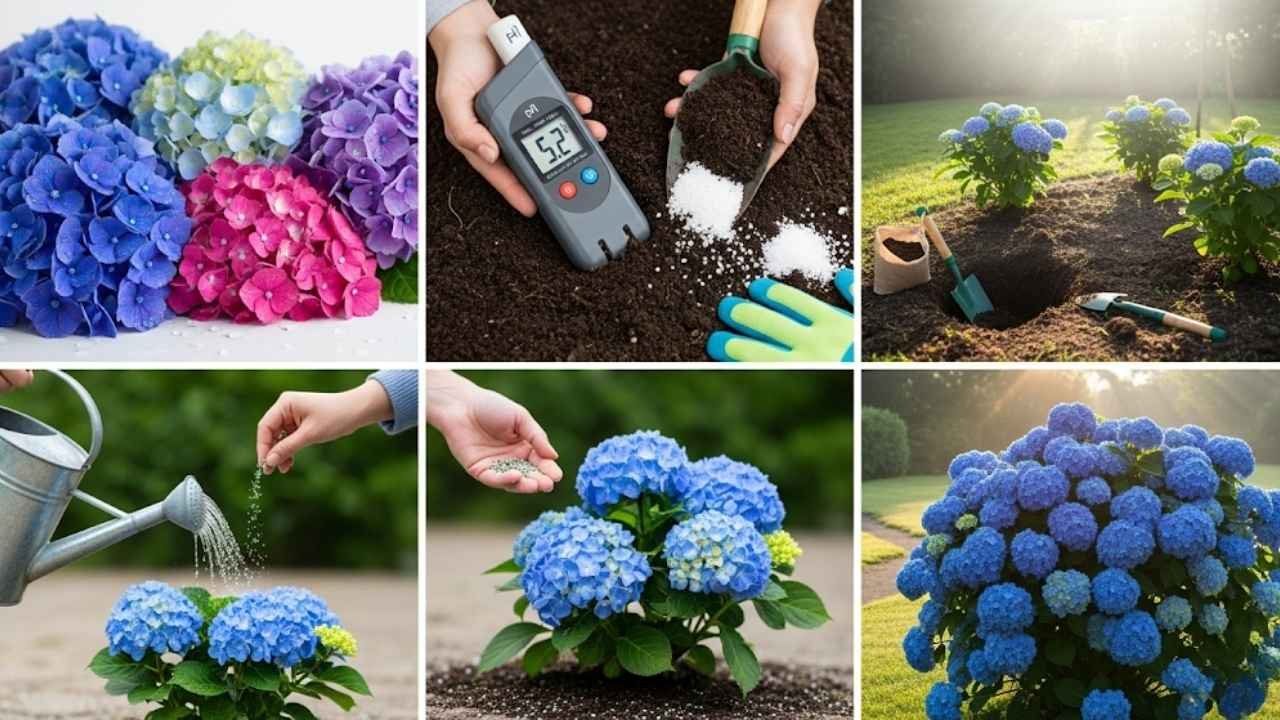Join on WhatsApp
Get the latest updates directly on WhatsApp – motivation, news & more!
Blue hydrangeas are some of the most stunning flowering shrubs you can grow in your garden. Their large, globe-like clusters of deep blue to soft sky-blue flowers are not only eye-catching but also symbolic of peace, gratitude, and heartfelt emotion. Knowing how to grow and care for blue hydrangeas is essential if you want to enjoy healthy plants and vibrant blooms all season long. Whether you’re a seasoned gardener or a beginner, this guide will walk you through everything from planting conditions to bloom maintenance, ensuring your blue hydrangeas stay as brilliant and beautiful as ever.
Understanding Blue Hydrangeas: What Makes Them Unique
Before you learn how to grow and care for blue hydrangeas, it’s important to understand what makes them unique among hydrangea varieties. Not all hydrangeas can be blue; only certain species—mainly Hydrangea macrophylla (Bigleaf hydrangea) and Hydrangea serrata—have the ability to produce blue flowers. Their color is heavily influenced by soil pH and aluminum availability in the soil.
In acidic soil (pH below 6), aluminum becomes available to the plant, which produces that characteristic blue color. In more alkaline soil, the flowers may turn pink or purple. This pH sensitivity is one of the most fascinating aspects of learning how to grow and care for blue hydrangeas successfully.
Soil Preparation to Grow Blue Hydrangeas
Proper soil preparation is the foundation of learning how to grow and care for blue hydrangeas. Blue hydrangeas require well-draining, moisture-retentive, and nutrient-rich soil that leans toward the acidic side. Here’s how to create the ideal soil conditions:
- Soil pH: Aim for a pH between 5.2 and 5.5. You can lower soil pH by adding elemental sulfur or aluminum sulfate.
- Organic Matter: Mix in compost or peat moss to improve water retention and nutrient content.
- Drainage: Make sure the soil doesn’t stay soggy. Hydrangeas hate “wet feet,” which leads to root rot.
Soil testing kits can help you monitor pH levels and adjust accordingly. Maintaining this balance is a crucial step in understanding how to grow and care for blue hydrangeas effectively.
Planting Blue Hydrangeas: Choosing the Right Spot
Choosing the right planting location is an essential part of learning how to grow and care for blue hydrangeas. These plants thrive in spots where they get morning sun and afternoon shade, especially in warmer climates.
Key Planting Tips:
- Spacing: Plant bushes 3 to 10 feet apart depending on the variety.
- Timing: The best time to plant blue hydrangeas is in early spring or fall.
- Depth: Dig a hole twice as wide as the root ball and just as deep. Backfill with enriched soil and water thoroughly.
Location affects flower size, color intensity, and plant health, so don’t underestimate the importance of this step in mastering how to grow and care for blue hydrangeas.
Watering and Feeding for Healthy Blue Hydrangeas
Watering and fertilizing correctly are vital components of how to grow and care for blue hydrangeas. These plants have shallow roots and require consistent moisture to thrive, especially during hot weather.
Watering Guidelines:
- Frequency: Water 1–3 times per week depending on weather conditions.
- Amount: Ensure the top 6 inches of soil remain moist.
- Method: Use drip irrigation or a soaker hose to avoid leaf wetness, which can lead to disease.
Fertilizing Tips:
- Type: Use a balanced, slow-release fertilizer formulated for acid-loving plants.
- Timing: Fertilize in early spring and again in midsummer.
- Avoid Overfeeding: Too much nitrogen can lead to lush leaves with few blooms.
Understanding how to grow and care for blue hydrangeas means maintaining the perfect balance between nourishment and hydration.
How to Maintain the Blue Color in Your Hydrangeas
Maintaining that brilliant blue color is one of the biggest concerns when figuring out how to grow and care for blue hydrangeas. As mentioned earlier, soil pH and aluminum availability are the two primary factors.
Tips to Keep Hydrangeas Blue:
- Add Aluminum Sulfate: Mix 1 tablespoon per gallon of water and apply monthly during the growing season.
- Mulch with Pine Needles: They naturally acidify the soil over time.
- Avoid Lime: It raises the pH and turns blooms pink.
Use the table below to understand the effect of pH levels on bloom color:
| Soil pH | Bloom Color | Aluminum Availability |
|---|---|---|
| 4.5–5.5 | Deep Blue | High |
| 5.6–6.5 | Purple | Medium |
| 6.6–7.5 | Pink | Low |
Being able to manipulate the flower color is part of the charm of learning how to grow and care for blue hydrangeas—it gives gardeners creative control over their landscape aesthetics.
Pruning and Deadheading Blue Hydrangeas
Pruning is not only a key to controlling plant size, but also crucial in how to grow and care for blue hydrangeas for better blooming. Incorrect pruning can remove the buds that would produce flowers the next season.
Pruning Guidelines:
- When: After blooming (late summer to early fall).
- What to Remove: Dead or weak stems, and old flower heads.
- Avoid: Cutting in late fall or early spring—it can eliminate next season’s blooms.
Deadheading Tips:
- Cut just above the first set of large leaves below the flower head.
- Use sharp, sterile pruners to avoid damaging the plant.
Correct pruning ensures that your blue hydrangeas bloom vigorously year after year, an essential part of how to grow and care for blue hydrangeas.
Common Pests and Diseases in Blue Hydrangeas
Like all plants, blue hydrangeas are vulnerable to certain pests and diseases. Knowing how to grow and care for blue hydrangeas includes being proactive about plant health.
Common Pests:
- Aphids
- Spider Mites
- Slugs and Snails
Common Diseases:
- Powdery Mildew
- Leaf Spot
- Root Rot
Preventive Care:
- Water at the base, not overhead.
- Provide good air circulation.
- Use organic or chemical treatments as needed.
Keeping your plants healthy is a crucial part of successfully learning how to grow and care for blue hydrangeas.
Seasonal Care for Blue Hydrangeas
Seasonal maintenance plays a significant role in how to grow and care for blue hydrangeas year-round.
Spring:
- Prune and fertilize.
- Apply mulch.
- Check soil pH.
Summer:
- Water deeply.
- Deadhead blooms.
- Watch for pests.
Fall:
- Stop fertilizing.
- Reduce watering.
- Protect roots with mulch.
Winter:
- In cold zones, cover base with straw or burlap.
- Avoid pruning.
- Inspect for freeze damage.
Tailoring your care by season ensures strong plants and vibrant flowers, completing the cycle of understanding how to grow and care for blue hydrangeas from one year to the next.
How to Grow and Care for Blue Hydrangeas: Final Thoughts
Learning how to grow and care for blue hydrangeas is a rewarding journey for any gardener. From understanding the science behind their brilliant blue hues to mastering soil preparation, planting, pruning, and seasonal care, every step brings you closer to a thriving, beautiful garden. Blue hydrangeas are more than just flowers; they are living art that changes with the soil and reflects the care you provide.
Whether you’re planting your first bush or refining your technique after years of gardening, following expert tips on how to grow and care for blue hydrangeas ensures a lush, colorful, and thriving display that will turn heads and warm hearts season after season.


